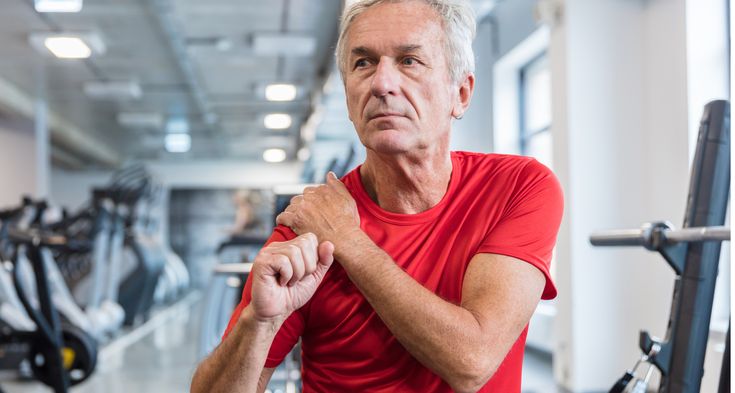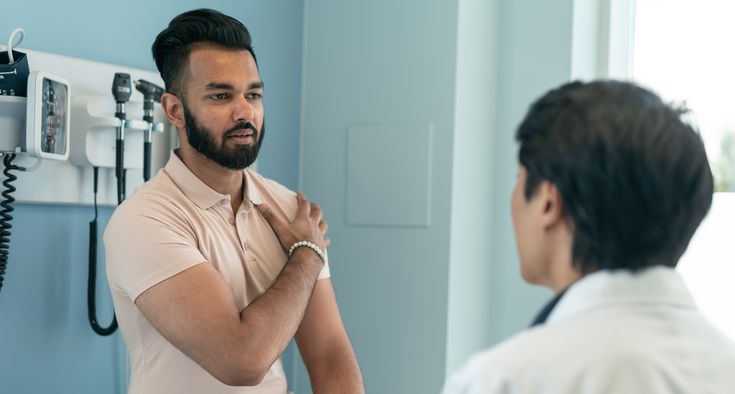
When Dr. William Estes isn’t in clinic or in an operating room, he might be golfing or playing tennis. Or running or snowboarding. The orthopedic surgeon with Southern Orthopedics & Sports Medicine - Mount Pleasant has been an athlete his whole life.
When his patients say they want to get back to the sports they love as soon as possible, he understands. He wants that, too.
But the Iowa Hawkeyes fan won’t hurry the process, as injuries take time to heal. He asks patients to commit to putting in the time and effort necessary to heal properly.
Estes’ areas of expertise include shoulder, knee and elbow injuries as well as shoulder and knee replacements. Because rotator cuff injuries are so common – particularly in athletes and those who perform repeated overhead movements – he ends up treating a lot of them. (Annually, almost 2 million Americans see a doctor because of rotator cuff tears, according to the American Academy of Orthopedic Surgeons.) Estes performs 200 to 250 rotator cuff repairs each year.
A torn rotator cuff may weaken your shoulder, which turns simple tasks – like brushing your hair or getting dressed – into a challenge. People over 40 are at the greatest risk for rotator cuff injuries.
Signs you may have an injured rotator cuff include shoulder pain – particularly when reaching overhead or behind, weakness or limited range of motion in the arm and a popping sound in the shoulder. First-line remedies include rest, ice packs, physical therapy and over-the-counter pain relievers and anti-inflammatories.
More severe injuries require surgery. We talked with Estes about what that entails.
Don't let pain keep you from enjoying life.
What exactly is the rotator cuff?
The rotator cuff is, collectively, made up of four muscles and their tendons that surround the shoulder joint. There’s the subscapularis, the supraspinatus, the infraspinatus and the teres minor, and they all originate off the scapula or shoulder blade. Together, they help stabilize your shoulder and allow you a range of motion.
What are the most common ways people injure their rotator cuff?
It could be from a fall or from lifting something heavy. As we age, we get weaker, and we’re more likely to injure ourselves doing something minor.
Acute tears are often related to an injury, although tears can also happen from overuse. That’s the kind you may not realize you have. Rotator cuff injuries are more common in your dominant arm.
Do people know when they’ve injured their rotator cuff?
Not always. In my patients who are over 50, maybe half of them remember a specific event when the injury occurred. I had a patient recently whose MRI showed a rotator cuff that had clearly been torn for months based on how much it had retracted and evidence of atrophy of the rotator cuff muscle. He didn’t remember injuring it.
What are the most common rotator cuff injuries?
You can have a partial tear, which generally doesn’t require surgery. Full-thickness tears – where the tendon has detached from the bone – usually do.
What conservative approaches do you try first for rotator cuff injuries? Or do you?
That’s always a discussion with patients. Different providers have different ‘practice personalities.’ I’m not a dictator; I’m an educator. Ultimately, it's the patient’s shoulder, and my job is to offer them options and advice.
For people with full-thickness rotator cuff tears, I strongly encourage them to get them fixed surgically. Over time, full-thickness tears can retract and become unrepairable. If people wait six months to a year and then say, ‘All right, I’m ready to get it fixed; I can’t take the pain anymore,’ they’re looking at a much bigger, more difficult surgery.
With partial thickness tears, though, we start out conservatively. A lot of times, it’s with a cortisone shot and physical therapy. Also, surgery may not be right for some elderly patients, so it’s appropriate to try conservative treatments on that population first.
Are there different kinds of rotator cuff repair surgery?
Best doctors. Amazing nurses. Remarkable care.
Click here to read more about our expert sports medicine care.
It’s almost always arthroscopic, meaning minimally invasive. And it’s always the same idea. There can be a bigger tears that require more anchors to fix the torn tendon, but the procedure is pretty much the same.
Are these surgeries done at an outpatient surgery center?
Yes, and people go home the same day.What's the recovery like after a rotator cuff surgery?
It’s six weeks in a sling, and I’m rigid on that. If you can’t commit to wearing that sling for six weeks, then I don’t think this surgery is for you. The risk of a retear is too high. After the six weeks in a sling, patients can expect three to four months of physical therapy. In general, if you talk to patients who’ve had the surgery, they'll tell you it took a year to get 100% back to normal.What about athletes – including amateurs – who tell you they don't have a year to wait to get back to their sport?
It doesn’t take a full year to get back to participating in sports; it’s often a year to get back to 100%. Patients can do as they choose, but my recommendation is almost always to allow the shoulder enough time to heal. For people itching to get back to tennis or golf, it’s appropriate to wait at least four months after surgery for golf. For tennis, we advise waiting four months for ground strokes and six months for serving and overhead motions.
When you say three to four months of physical therapy, is that in an office setting or at home?
A combination, usually. For the first six weeks, it’s all about getting the repair to heal. Physical therapy should start one week after surgery. The physical therapist performs passive motion therapy for about six weeks post-op. Then, you move to what’s called active motion, where you start to lift your arm. The second phase usually lasts 10 to 12 weeks.
Are there precautions people can take to protect their rotator cuffs?
There are some things you can do, like using proper lifting techniques, avoiding repetitive overhead movements, strengthening the rotator cuff and shoulder muscles and stretching regularly. But none of those completely eliminate the risk of tearing.
Anything else you think is important to know about rotator cuff injuries?
Yes. I get a lot of questions about stem cell and platelet-rich plasma (PRP) injections as treatment options, and I always tell patients these are still very experimental.
As surgeons, we realize nobody wants surgery. And most of us want surgery to be a last resort, too. But I hate seeing people wasting a lot of money on things that are just not going to be helpful.
My advice: Listen to your physician. Don’t try to take the easy way out, as it may not be that easy in the end.











